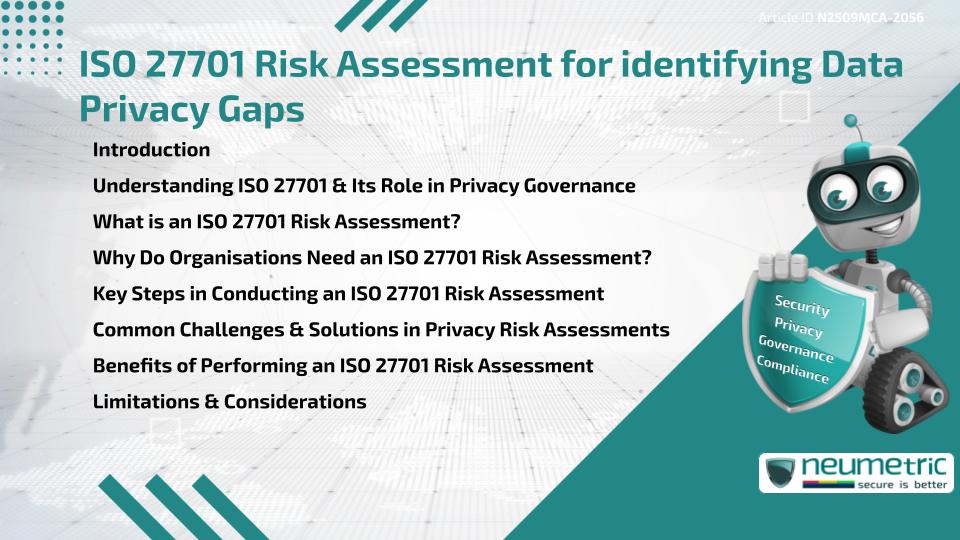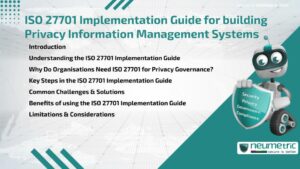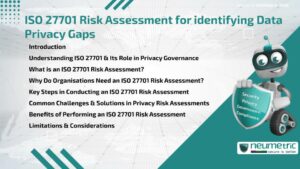Table of Contents
ToggleIntroduction
The ISO 27701 Risk Assessment helps Organisations strengthen their Data Privacy practices by identifying weaknesses & ensuring alignment with Global Privacy Regulations. As an extension of ISO 27001 & ISO 27002, ISO 27701 provides a Framework for managing Personally Identifiable Information [PII]. This Article explores the purpose, steps, challenges & benefits of conducting a Privacy focused Risk Assessment under ISO 27701.
Understanding ISO 27701 & Its Role in Privacy Governance
ISO 27701 is an International Standard designed to establish, maintain & improve a Privacy Information Management System [PIMS]. It builds on existing Information Security Frameworks by integrating Privacy specific requirements.
By conducting an ISO 27701 Risk Assessment, Organisations can better understand the Risks associated with collecting, processing & storing PII. For more details, see ISO.org.
What is an ISO 27701 Risk Assessment?
An ISO 27701 Risk Assessment is a structured process that evaluates how well an organisation manages Privacy Risks within its PIMS. It identifies Threats, Vulnerabilities & Compliance Gaps that could lead to Data Breaches or Violations of laws like GDPR or HIPAA.
The outcome is a clear Roadmap of Corrective Actions, enabling Organisations to mitigate Privacy Risks proactively. Guidance can also be found in the NIST Privacy Framework.
Why Do Organisations Need an ISO 27701 Risk Assessment?
With growing Regulatory Scrutiny & Customer expectations around Privacy, Organisations must ensure their Controls are adequate. An ISO 27701 Risk Assessment helps by:
- Identifying Gaps in Privacy Controls & Governance.
- Demonstrating Accountability to Regulators & Stakeholders.
- Reducing Risks of Fines, Reputational Harm & Data Misuse.
- Supporting Compliance with multiple Privacy Regulations simultaneously.
For broader insights, see the OECD Privacy principles.
Key Steps in Conducting an ISO 27701 Risk Assessment
- Scoping – Define Systems, Processes & Data flows to be assessed.
- Data Mapping – Identify where PII is collected, stored & shared.
- Risk Identification – List Potential Threats such as Unauthorised access or Data leakage.
- Risk Analysis – Assess Likelihood & Impact of identified Risks.
- Control Evaluation – Compare existing Controls against ISO 27701 requirements.
- Mitigation Planning – Recommend Corrective Actions to close Gaps.
- Ongoing Monitoring – Establish regular reviews to Track Progress & Adapt to changes.
Practical guidance is also provided in the IT Governance ISO 27701 resources.
Common Challenges & Solutions in Privacy Risk Assessments
- Complex Data Ecosystems – Use Automated Tools for Data Discovery & Classification.
- Regulatory Overlap – Map requirements across Multiple Jurisdictions.
- Limited Awareness – Conduct regular Staff Training on Privacy obligations.
- Resource Constraints – Prioritise High-impact Risks for Remediation.
The NCSC UK Risk Management guidance can help in overcoming these challenges.
Benefits of Performing an ISO 27701 Risk Assessment
- Enhanced Privacy Governance – Improves Accountability & Transparency.
- Regulatory Alignment – Demonstrates Compliance with GDPR, HIPAA & Other Laws.
- Reduced Breach Risks – Identifies & Mitigates Vulnerabilities before they are Exploited.
- Trust & Reputation – Builds confidence with Clients, Partners & Regulators.
Limitations & Considerations
An ISO 27701 Risk Assessment provides valuable insights but is not a One-time exercise. Privacy Risks evolve with new Technologies, Regulations & Business Models. Continuous Monitoring, Leadership Commitment & Skilled Personnel are essential for Long-term effectiveness.
Takeaways
- The ISO 27701 Risk Assessment identifies Data Privacy Gaps in alignment with ISO 27701 requirements.
- It involves Data Mapping, Risk Analysis & Control Evaluation.
- Organisations benefit through stronger Privacy Governance, Compliance & Trust.
FAQ
What is an ISO 27701 Risk Assessment?
It is a structured review of Privacy Practices to identify Gaps & Risks within a Privacy Information Management System.
Why is it important for Organisations?
It reduces Privacy Risks, ensures Regulatory Compliance & strengthens Trust.
Who should conduct the Assessment?
Compliance Teams, Data Protection Officers & Privacy Specialists.
How often should it be Performed?
At least Annually or Whenever significant changes occur in Data Processing activities.
Does it guarantee Compliance?
No, but it provides a Strong Foundation for achieving & maintaining Compliance.
References
- ISO.org – International Standards
- NIST – Privacy Framework
- OECD – Privacy Principles
- IT Governance – ISO 27701 Resources
- NCSC UK – Risk Management Collection
Need help for Security, Privacy, Governance & VAPT?
Neumetric provides Organisations the necessary help to achieve their Cybersecurity, Compliance, Governance, Privacy, Certifications & Pentesting needs.
Organisations & Businesses, specifically those which provide SaaS & AI Solutions in the Fintech, BFSI & other regulated sectors, usually need a Cybersecurity Partner for meeting & maintaining the ongoing Security & Privacy needs & requirements of their Enterprise Clients & Privacy conscious Customers.
SOC 2, ISO 27001, ISO 42001, NIST, HIPAA, HECVAT, EU GDPR are some of the Frameworks that are served by Fusion – a SaaS, multimodular, multitenant, centralised, automated, Cybersecurity & Compliance Management system.
Neumetric also provides Expert Services for technical security which covers VAPT for Web Applications, APIs, iOS & Android Mobile Apps, Security Testing for AWS & other Cloud Environments & Cloud Infrastructure & other similar scopes.
Reach out to us by Email or filling out the Contact Form…





